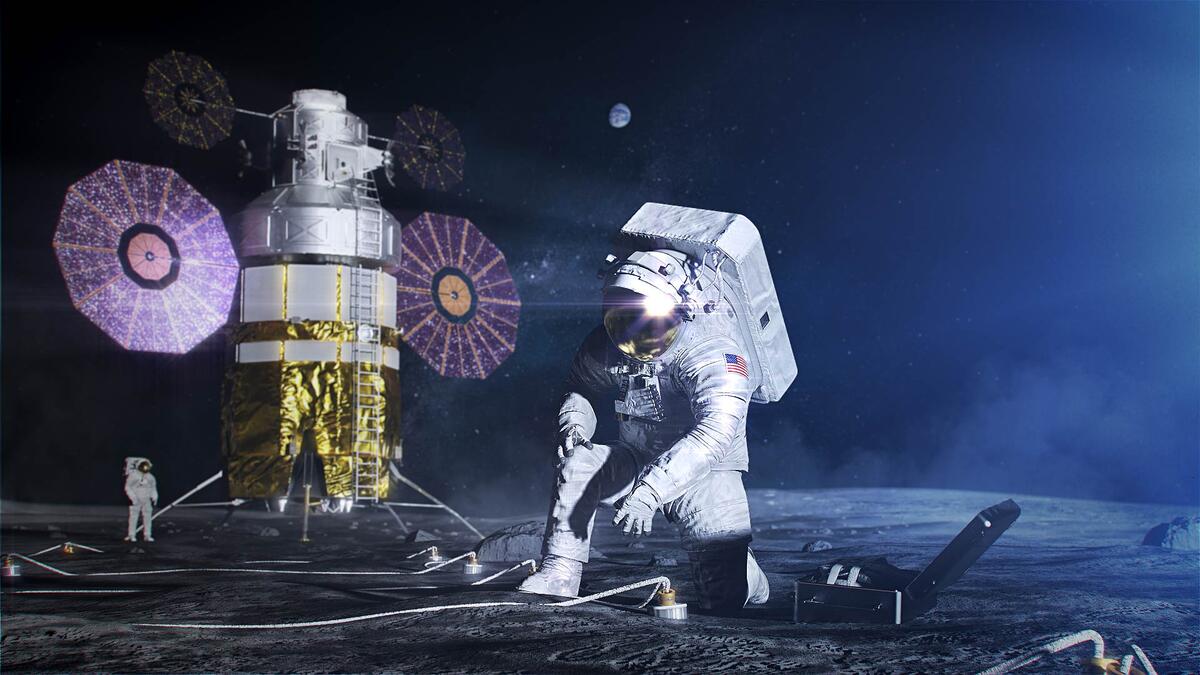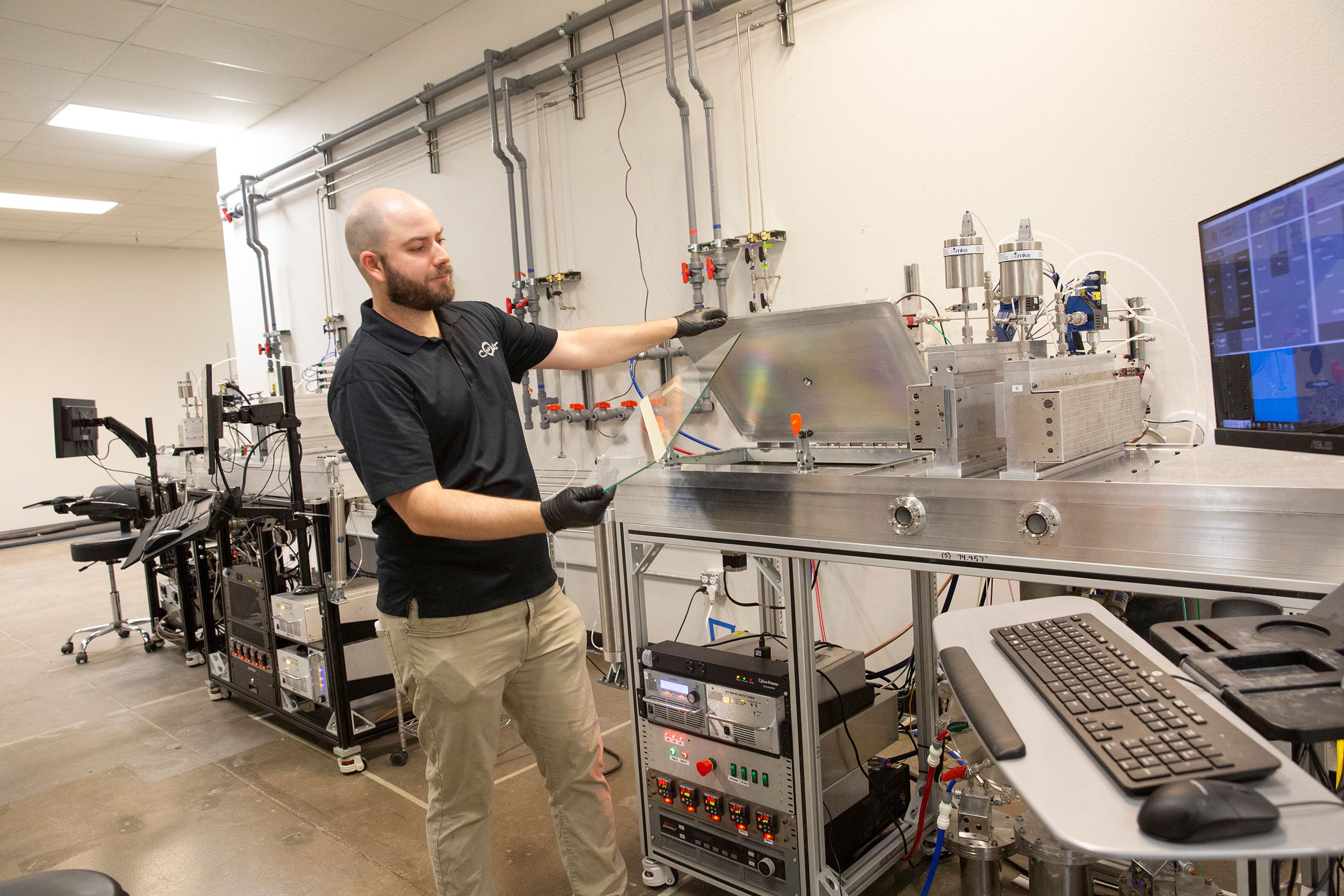NASA is reuniting humanity with a place not visited in more than 50 years: the moon. The Artemis missions look to establish a base camp on the moon’s surface and launch an orbiting spaceship called Gateway, where astronauts will transfer to a moon-landing craft.
Thanks to exponential technological advances since the late 1960s, astronauts will be equipped with a new spacesuit known as the Exploration Extravehicular Mobility Unit, or xEMU. The new suit will include an improved helmet that resists the fogging that obscures the wearer’s vision.
NASA has selected Swift Coat, a materials science company founded by Zachary Holman, an Arizona State University electrical engineering professor and incoming Fulton Schools vice dean for research and innovation, and his co-founder, ASU alumnus Peter Firth, to develop a coating to keep xEMU wearers’ vision unobstructed.
Developing a clear path forward
Lunar surface temperatures can reach as low as minus 250 degrees Fahrenheit. These freezing temperatures cause the water droplets in an astronaut’s breath to condense inside a spacesuit helmet, dangerously obscuring an astronaut’s vision.
“If you’ve ever gone snorkeling or scuba diving, you are probably familiar with the common solutions to fogging, like rubbing shampoo, dish soap or even spit on the inside of the goggles,” says Firth, who studied under Holman for his graduate degree in electrical engineering. “These methods take advantage of the surfactants in each compound, which reduce surface tension and prevent water from forming droplets and scattering light.”
To ensure astronauts can see out of space helmets, anti-fogging agents are used. However, current anti-fogging solutions for space suits have a few problems. They are difficult to apply properly on a space helmet, need frequent reapplication and become airborne chemicals that irritate wearers’ eyes when they evaporate.
Enter Swift Coat, which produces coatings for materials with purposes such as resisting dirt accumulation on solar panels and windows. The company uses a manufacturing method called Aerosol Impact Driven Assembly, or AIDA, invented by Firth and Holman during Firth’s graduate studies.
Swift Coat uses the AIDA process to produce the anti-fog coating in a manner that can adhere to uneven surfaces like a space helmet. The anti-fog coating features a nanoscale textured surface that attracts water to its surface and keeps the droplets from condensing.
The coating doesn’t evaporate and won’t need to be reapplied to the xEMU helmet.
“We’ve applied our learning on how to make coatings that survive a quarter century’s worth of scrubbing, scratching, cleaning, freezing, heat waves, hail and haboobs to this anti-fog coating and expect to deliver a product that will outlast the useful life of the helmet,” Firth says.
Peter Firth, a co-founder of Swift Coat, operates machinery to apply a coating to a plate of glass at the company’s facility in Phoenix. Photo by Erika Gronek/ASU
Taking an anti-fog coating out of this world
In 2023, NASA selected Swift Coat as part of the Small Business Innovation Research program. The program, run by the U.S. Small Business Administration, connects small businesses with funding from government agencies to meet their needs.
Firth says Swift Coat applied to develop the xEMU anti-fog coating after hearing about the opportunity from other ASU affiliates who started their own companies.
“We’re close with a lot of other ASU startups, and we all tend to let each other know about opportunities we find that might be a good fit,” he says.
For the xEMU project, Swift Coat will work with NASA engineers to understand how to adapt the anti-fogging agent for the suit’s helmet.
The company will spend six months in the first phase developing variations of the formula. At the end of the six months, they will provide samples for NASA to review.
If one of the formulas meets the agency’s needs, Swift Coat will move to the project’s second phase to build a prototype xEMU helmet for testing.
To infinite uses and beyond
Scott Smas, associate director of ASU’s NewSpace intiative, which connects ASU faculty with government and private sector opportunities in the space industry, is helping Swift Coat gain connections for the xEMU project.
“We’ve met a series of companies to introduce to Swift Coat representatives, so that they may find areas of common interest and support for the second phase of the program,” Smas says. “This could involve subcontracts with some research and development businesses that complement what Swift Coat does.”
NewSpace also assists entrepreneurs at ASU to find multiple buyers in the space industry for their products. Smas names buyers in space tourism, extraterrestrial habitat development and space camera lens production as potential markets for Swift Coat products.
Firth is optimistic about the future of Swift Coat’s products for space use.
“There are hundreds of potential applications for our core technology relevant to NASA,” he says. “We’re confident that when this first product is shown to be successful, we’ll have the opportunity to work with NASA on more projects.”
Firth also believes that space is only one market for Swift Coat. He says that the need for anti-fog coatings is rapidly growing in a variety of industries, including the automotive, window, aviation, defense, refrigeration and camera sectors.
“We have relationships with companies in all of these industries who are excited to implement the coating used by astronauts to walk on the moon on their products,” Firth says.
So far, the company’s success in coating development has resulted in the need to expand from its 600-square-foot ASU MacroTechnology Works lab facility. Swift Coat is now located in north Phoenix in a 16,000-square-foot manufacturing facility and uses MacroTechnology Works’ specialized equipment when needed.
“ASU is constantly demonstrating that technologies produced in their ecosystem have strong commercial potential,” Firth says. “I think each success like this bolsters that reputation and makes finding the capital, partners and customers for the next amazing product developed at the university easier.”
Top photo: An artist’s rendering shows astronauts in spacesuits on the moon near a landing craft. Swift Coat, a company started by ASU electrical engineering Professor Zachary Holman and ASU alumnus Peter Firth, is developing a coating for a NASA spacesuit helmet that resists fogging. Graphic courtesy NASA
More Science and technology

4 ASU researchers named senior members of the National Academy of Inventors
The National Academy of Inventors recently named four Arizona State University researchers as senior members to the prestigious organization.Professor Qiang Chen and associate professors Matthew…

Transforming Arizona’s highways for a smoother drive
Imagine you’re driving down a smooth stretch of road. Your tires have firm traction. There are no potholes you need to swerve to avoid. Your suspension feels responsive. You’re relaxed and focused on…

The Sun Devil who revolutionized kitty litter
If you have a cat, there’s a good chance you’re benefiting from the work of an Arizona State University alumna. In honor of Women's History Month, we're sharing her story.A pioneering chemist…



